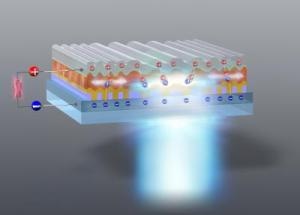Jun 3 2019
Japanese researchers have shown that a new kind of laser diode predicated on organic semiconductors and one that has been elusive for a long time could now be achieved.
 Schematic representation of an organic semiconductor laser diode producing blue laser emission under electrical excitation. (Image credit: Center for Organic Photonics and Electronics Research, Kyushu University)
Schematic representation of an organic semiconductor laser diode producing blue laser emission under electrical excitation. (Image credit: Center for Organic Photonics and Electronics Research, Kyushu University)
This breakthrough study paves the way to further expand the use of lasers in other applications like optical communications, biosensing, healthcare, and displays.
Organic laser diodes are traditionally regarded as a holy grail in the field of light-emitting devices (LEDs). Instead of the inorganic semiconductors, like gallium nitride and gallium arsenide, utilized in conventional devices, organic laser diodes utilize carbon-based organic materials to produce light.
The lasers are analogous to organic light-emitting diodes, or OLEDs, in a number of ways; a thin layer of organic molecules in the OLEDs produces light upon applying an electric current. As a matter of fact, OLEDs have turned out to be the preferred choice for smartphone displays due to their vivid colors and high efficiency, which can be easily altered by designing novel organic molecules.
Although organic laser diodes create a much purer light that allows for further applications, they need currents that are many degrees higher than those utilized in OLEDs to realize the lasing process. These adverse conditions caused formerly examined devices to break down much before the lasing process could possibly be visualized.
To further complicate this development, there were previous claims of achieving electrically produced lasing from organic materials, but these turned out to be wrong on a number of instances, with other kinds of phenomena being mistaken for lasing due to inadequate characterization.
However, researchers from the Center for Organic Photonics and Electronics Research (OPERA) at Kyushu University have now reported that they have sufficient data to credibly demonstrate that organic semiconductor laser diodes have been ultimately realized. The results of study have been reported in the journal, Applied Physics Express.
I think that many people in the community were doubting whether we would actually one day see the realization of an organic laser diode. but by slowing chipping away at the various performance limitations with improved materials and new device structures, we finally did it.
Atula S. D. Sandanayaka, Study Lead Author, Center for Organic Photonics and Electronics Research, Kyushu University
In the lasing process, a huge amount of electrical current is injected into the organic layers to realize a condition known as population inversion. Conversely, many organic materials are extremely resistant to electricity which makes it rather hard to obtain sufficient electrical charges in the materials prior to their heating up and burning out. And added to this, a range of loss processes, which are integral in a majority of organic devices and materials functioning under high currents, reduces efficiency, thus increasing the required current even higher.
Hence to resolve these problems, the research team, headed by Professor Chihaya Adachi utilized BSBCz—a highly efficient organic light-emitting material that has a low amount of losses and a comparatively low resistance to electricity, even when injected with huge amounts of electricity. However, it is not enough to have just the right material.
In addition, the researchers designed a special device structure that has a network of insulating material on top of one of the electrodes used for injecting electricity inside the organic thin films. Known as distributed feedback structures, these grids are known to create the optical effects needed for the lasing process; however, the team took it one step further.
By optimizing these grids, we could not only obtain the desired optical properties but also control the flow of electricity in the devices and minimize the amount of electricity required to observe lasing from the organic thin film.
Chihaya Adachi, Professor, Department of Applied Chemistry, Kyushu University
The scientists are so confident in the ability of these novel devices that they established a startup company called KOALA Tech Inc., short for Kyushu Organic Laser Technology Inc., on March 22nd, 2019, to speed up studies and overcome the last barriers that are still remaining for applying the organic semiconductor laser diodes in commercial applications.
Professor Chihaya Adachi, Dr Fatima Bencheikh, Dr Jean-Charles Ribierre, and Dr Takashi Fujihara, are the founding members of KOALA Tech Inc., and currently, they are working hard to enhance the performance of their organic laser diodes to bring this most sophisticated organic light-emitting technology to the world.